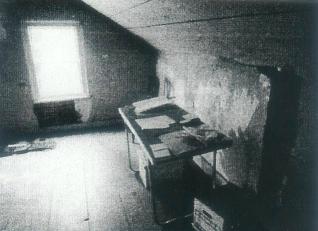HVVA
NEWSLETTER, FEBRUARY, 2004
FROM
THE JOURNAL
Thursday,
January 29, 2004 Met with Todd Scheff and Dave Minch at the
General Putnam 2-story brick house in Upper Red Hook (Dut-RH-21) that
has recently been bought and is undergoing restoration. The historic
marker dates the house to 1740 but the only clear evidence we found
is early Federal, late 18th century, with English framing. The floors
are supported on summer beams and joists. The gable roof, perhaps
an alteration, is framed with sawn rafters resting on a hewn ridge
beam that is supported on king posts. It is a rafter system I have
never seen before on an historic Hudson Valley building. The ridge
beam and posts are re-used. The house contains many original features.
We drove to the Conyn/Van Rensselaer house(Col-Cla-6)
on Spook Rock Road in Claverack and met with Alvin Sheffer to examine
the house. Dave Minch, an architect from Saugerties, had come along
for his knowledgeable input on how to restore the three damaged beams
in the room that had the jambless fireplace. He has four ideas and
will write them up. We discover that the roofers in the loft and the
boards in the hearth cradle in the cellar are all feathered, angled-lap,
a feature common in fine 18th century houses in Albany County but
not found in Dutchess and Ulster Counties to the south. Its use is
thought by some to act as a plank roof, to shed water, and by other
that the feathering was a way to strengthen the surface.
We go to Nancy Ginsberg's house in Claverack, the present owner, and
talk with her about the restoration project. She has located some
used fir beams for sale in Pine Plains. Dave has told us that the
strength of beams can easily be tested. He did it recently at the
Kierstead house in Saugerties.
Among us there is an interest in the history and geography of this
area of Columbia and northern Dutchess Counties that lies between
the Livingston and Rensselaer Patents. There have been many changes
to the roads and traffic patterns in the area. Many of the original
roads and paths are hidden in the contemporary landscape. There remain
a number of 18th century buildings in the area that would be interesting
to map, document and compare.
From the Editor; The committee of the Palatine Farmstead
in Rhinebeck, Dutchess County, voted to allow HVVA to use the south
loft room of the house as a temporary home and a place to organize
a display concerning the hay barrack. The room is simply finished
and whitewashed, 15'9" wide and 13'7" deep. with a 6'8"
ceiling. It has two windows. It is presently used for storage of artifacts
found at the site. These will be moved to the north room.
We are hoping to have a good meeting this week-end
(January 14) at the Marbletown firehouse. There are a number of new
topics to discuss including the offer of a house and Dutch barn in
Milford, New Jersey that is about to be repaired and made available
by the National Parks Service. Hubert de Leeuw, our friend from Belgium
is working with ICOMOS, the organization that sponsored the recent
Year of the Farm Conference in Holland, to bring foreign interns to
America to help in the work of a Dutch barn and vernacular architecture
study and inventory. Hubert stresses that the project needs to cover
a wide area and show collaboration between regional groups.
The Dutch Barn Society (DBPS) has a new home in Schenectady
County at the Mabee Farm Historic Site, 1080 Main Street, Rotterdam
Junction, NY 12150. Kieth Cramer has already sent a letter to the
US/ICOMOS in Washington, DC expressing the DBPS interest in the intern
project. Peter Sinclair, Editor: Spillway Farm, West Hurley, NY

New HVV A Headquarters. South Loft Room
Palatine Farmstead (Dut-Rhi-20) Rhinebeck, Dutchess Co., NY
Note: Included in this newsletter was the special report
on the Solite Dutch Barn.